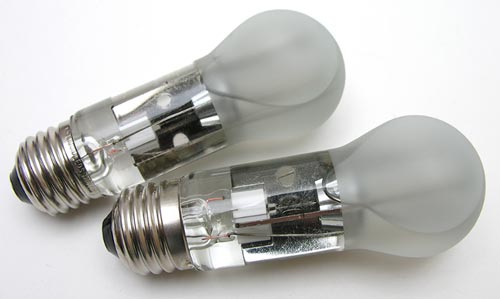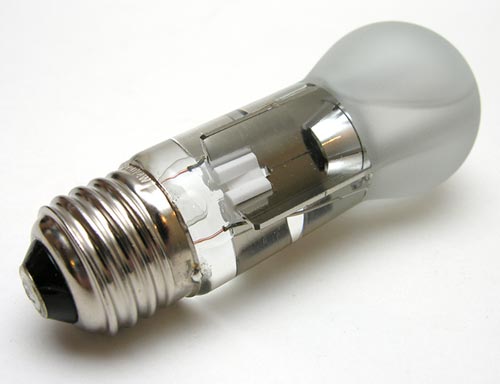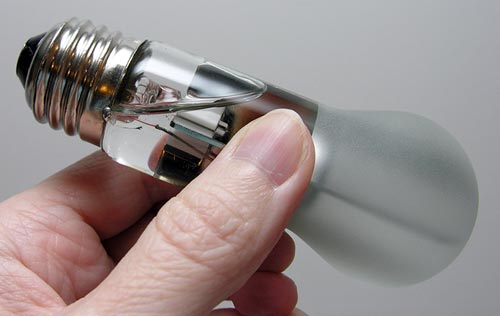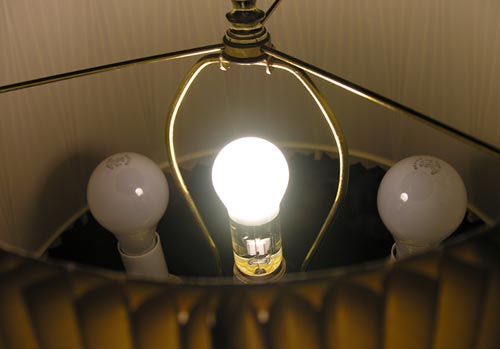
Do the words Going Green, cause you to roll your eyes or open them? I fall into the eye opening group as I’m a self-proclaimed tree hugger that hates to hear about the the polar ice caps melting and oceans warming. We are big on recycling at my house and we’ve switched 90% of the incandescent light bulbs over to compact fluorescents. CFLs don’t use as much electricity, which good for the planet and good for your electric bill and your wallet. What about LED light bulbs though, are they better than CFLs? Let’s take a look at the HydraLux-4 bulbs from EternaLEDs and see.
Features
Saves on average $13.96 per year*
Costs $1.75 to run per year*
Saves $157.00 over lifetime in bulb and electricity costs*
Lasts 35,000 hours or 35x longer than incandescent bulbs
Fully Dimmable
Contains No Mercury or Hazardous Substances
Approved for Outdoor and Indoor Use
No Flickering, No Headaches
Runs Cools
2 Year Warranty & 30 Day Money Back Guarantee
* At 8 hours usage per day, 365 days per year and $0.15/kWh

They sent me a Warm White and a Daylight White version of their bulbs. Both look exactly the same and are direct replacements for any standard threaded light bulb socket (E27 medium base socket) indoors or outdoors.

The first thing you notice when you pick up one of these bulbs is the weight. They are heavy little guys. The next thing you notice is that they are filled with liquid. Unlike CFL bulbs that contain Mercury, the liquid inside the HydraLux-4’s is harmless paraffin oil that has been tested and certified safe to UL and ROHS standards. This liquid keeps the bulb cool to the touch.
These bulbs use 4W to put out as much light as a 25W standard “A-Shape” incandescent bulb while lasting 35x longer. 25W doesn’t sound like a lot though… Most of the bulbs in my lamps are at least 100W.

Here you see one of the HydraLux-4 bulbs installed in one of my floor lamps. As I feared, by itself, it does not put out enough light to really be useful all by itself. I was surprised how cool they run though. I left it on for an hour and it was just warm to the touch.
As for the difference between the Warm White and Daylight White bulbs, it’s not a lot. The only difference is the brightness. In order to get Warm White, the white LED’s are covered with a phosphor coating to make them “warmer” and thus reducing the light output slightly.
Here are a couple of questions that I asked Jeff of EternaLEDs:
Q: Is 25W the max wattage bulb you sell of this type? Just wondering because they really don’t put out enough light to be used all by themselves (in my opinion).
A: 25W equivalent is the max at the moment but we’re planning on coming out with 8,12, & 16W versions by the end of the year. The 16W version may not be available because we want to keep the costs low enough to be practical – but 8 &12W versions are very likely a go. We realized that these weren’t very bright to begin with – they’re not meant to replace every light in a home but more for low-light/ task lighting applications like a desk lamp, wall sconces, accent light, chandelier etc where incandescents are normally being used or Compact Fluorescent Bulbs would just look unattractive in the fixture.
Q: What is the lifetime for a bulb? Is there a difference in the lifetime of a cool vs. warm light?
The lifetime is 35,000 hours. Many manufacturers prior, when LEDs first came out were listing 100,000 hours and 50,000 hours for 1st and 2nd generation bulbs. 1st generation would be something like this: http://www.eternaleds.com/PAR16_LED_Spotlight_2W_Halogen_JDR_48_LED_p/hjdr-jdr.htm uses what’s called 5mm LEDs. (low-power) 2nd generation bulbs – using heavy metal heatsinks like this: http://www.eternaleds.com/ProductDetails.asp?ProductCode=HP-7 uses high power LEDs (1W – but heatsink isn’t very efficient) These ratings were simply inaccurate and since then, after being able to test for 2-3 years, we’ve found that the lifetime is closer to 35,000 hours. Note after this time, the bulbs are supposed to be at 70% of their original brightness – they don’t just “burn out” like regular lightbulbs. 3rd generation designs – include a number of more efficient designs – from plastic housings, less metal being used with a larger surface area to increase airflow…. like the HydraLux or this: http://www.eternaleds.com/PAR38_LED_Floodlight_18W_Eternaleds_Quanta_18_p/quanta-18.htm
Besides the fact that these LED light bulbs are not available in higher wattage (brighter) versions, they are currently too expensive for an average person to buy to replace all the bulbs in their home. I look forward to the time when LED bulbs are less expensive and can provide the same light as a 100W incandescent bulb. In the mean time, I’ll continue using my CFLs and make sure that I take them to the recycle center instead of just throwing them away when they burn out.



Gadgeteer Comment Policy - Please read before commenting
Two quick questions: What’s the actual cost, and can they be used inverted?
My problem with information pages such as this one is that y’all think we’re idiots. You don’t mention the actual watts consumed by the bulb; you don’t mention the lumens of light output; you don’t even compare the light output of one LED bulb with that of a 100W incand. bulb. These are essential facts. I can calculate all by my lonesome the cost per year IF I know the actual wattage consumed by the bulb. Let’s improve the fact presentation.
Once more this whole using which bulbs is just about “How much juice does it burn?” I’d like to point out that trying to find an equation which includes electrical usage, component fabrication/creation, and final construction has been beyond my capabilities to research. For example – an LED (as I have noted) uses an artificial saphire substrate. That artificial saphire should require formation in a 3000 degree plus electric oven maintained for 7 or 8 days. What I haven’t seen is just how many substrates are created for individual LEDs.
I have a hunch that a simple 75 watt incandescent bulb is almost nil (relatively speaking) an energy expenditure to put together. And it contains nothing of the environmental significance that the mercury in a flourescent does. Couple that with the real usage of fixtures in the average 1600 sq. ft. home and you are not gonna save anywhere near enough in our homes to offset the huge waste in New York and Chicago as empty skyscrapers are lit up (inside and out) throughout the night.
Incandescent bulbs are still around in 2009 for a reason. They are highly evolved and offer consistent light for the lifetime of the bulb. And you can get four for a buck or so. They are extremely important in many industries, which is why they will be around for a lot longer.
CFLs are expensive to produce, contain mercury, and are very dangerous when they explode (which happens often when they get to the end of their useful life, at least in my experience). They spew mercury vapor into the air you breathe. In many places, it’s illegal to throw them away but household recycling won’t accept them. You have to drive your incredibly inefficient internal combustion engine to the nearest Home Depot or Lowe’s for recycling (or do what I suspect most people do: wrap them in newspaper and toss them in the trash).
Compare this to a normal incandescent bulb: the glass will break down back to sand, the metal used will rust away, and all is well with the world.
Look, it said puts out about as much light as a 25 watt incandescent bulb, it uses four watts. and as far as a normal bulb being so great because the glass will break down to sand, etc.
Incandescent bulbs are in general about 10% efficient. So your 60 watt bulb is basically a 50-some odd watt heater. The amount of CO2, particulates, and mercury, emited during the generation of this excess current are its main problem.
I’m still using halogen as it’s super bright!
I live in Houston, TX. It’s not as hot as some places, but it’s hot enough, long enough for air conditioning to be a much bigger power consumption issue than lighting.
There is a huge push to adopt lower-power devices for lighting but almost no push to adopt any kind of air conditioning system improvement.
When the U.S. drops it’s ban on solid-state coolers (Peltier junctions) I will start considering spending money on improving the power consumption efficiency of my home. (note, you can get junctions, but they are small and most usually incorporated into an existing product.)
And before you jump me for being an electricity waster, my electric bill for the last 11 years has been less than $200 -any- month of the year, and most months much less than $100 and I live in a 30 year old, 2200 square foot stick-built house.
@phil – Can you please provide a reference for this US ban on Peltier junction devices. I thought they weren’t used in things larger than dorm fridges due to inefficiency. As far as I know, most other countries still also use Freon-based cooling technology, at least for homes and cars. Larger scale cooling uses amonia and other mediums.
LED bulb reliability – HIGH FAILURE RATES
The life span of LED bulbs is vastly overstated by the manufacturers and vendors. Some of the bulbs I have purchased only lasted two weeks at no more than a couple hours use per day. Very disappointing (maybe 30 hours lifespan).
I am a big fan of LED lighting. Choose a bulb that fits the application (lumens and color) and you will be happy. Unfortunately many manufacturers and vendors overstate (I’m being kind here) their products specifications.
I have purchased 45 LED bulbs and have had mixed reliability.
The good news – some are very reliable. I have five LED bulbs outside that have run dusk to dawn for two years with no problems.
The bad news – some bulbs are VERY unreliable. VERY high failure rates.
I purchased 12 of one type LED bulb and 12 out of 12 have failed (8.5W product 47856 from LEDLight.com). 100% failure rate. To make matters worse they are refusing to replace them now.
Beware of LEDLight.com. This company is selling products that they know are defective. No support for failed LED bulbs. These bulbs are very expensive ($20 – $105) and in some cases last only two or three weeks. They refuse to replace defective bulbs. LEDLight.com is selling known defective products and has bad customer service.
ledlight.com, LED, problem, fail, failure, burnout, quit, reliability, unreliable, review
When are you coming out with higher wattage versions?